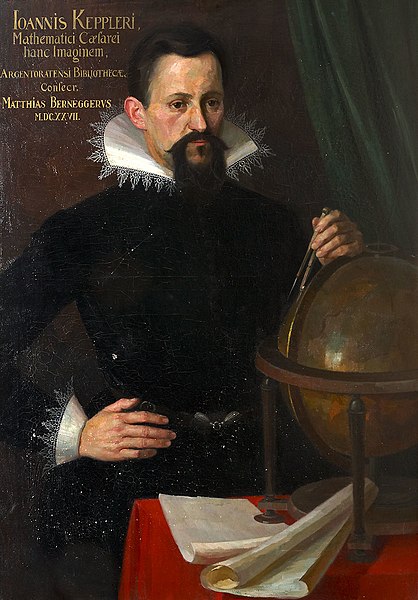Johannes Kepler (1571-1630) was a German mathematician, astronomer, and astrologer whose pioneering work revolutionized our understanding of the universe.
He is best known for formulating the laws of planetary motion, which described the precise movements of planets around the sun.
Kepler’s discoveries shattered the prevailing belief in circular orbits and introduced the concept of elliptical orbits, laying the foundation for modern celestial mechanics.
His contributions to optics, astronomical instrumentation, and the compilation of accurate astronomical tables further solidified his status as a key figure in the scientific revolution.
Kepler’s work not only transformed astronomy but also influenced later luminaries like Isaac Newton. His groundbreaking achievements continue to inspire scientists and shape our understanding of the cosmos.
Accomplishments of Johannes Kepler
1. Laws of Planetary Motion
Johannes Kepler formulated three fundamental laws that describe the motion of planets in their orbits around the sun. The first law, known as the law of ellipses, states that the planets move in elliptical paths, with the sun located at one of the foci of the ellipse.
Also Read: Facts About Johannes Kepler
This law challenged the prevailing belief in circular orbits and provided a more accurate description of planetary motion.

2. Discovery of Elliptical Orbits
Kepler’s observation of planetary motion led him to discover that the orbits of planets are not perfect circles, as previously believed, but rather ellipses. This realization was a significant departure from the geocentric model of the universe, which assumed circular orbits.
Also Read: Nicolaus Copernicus Facts
Kepler’s discovery of elliptical orbits revolutionized our understanding of the solar system and laid the foundation for future developments in celestial mechanics.
3. Kepler’s Supernova
In 1604, Kepler witnessed and studied a supernova, a rare event where a star explodes and becomes extraordinarily bright. His meticulous observations of this celestial phenomenon challenged the prevailing Aristotelian notion that the heavens were unchanging and perfect.
Kepler’s detailed documentation of the supernova and his recognition of its significance contributed to the understanding of stellar evolution and had a profound impact on the field of astronomy.
4. Book: Astronomia Nova
In 1609, Kepler published his monumental work titled “Astronomia Nova” (The New Astronomy). This book presented his first two laws of planetary motion, along with a wealth of observational data and mathematical calculations.
It was a groundbreaking publication that revolutionized the field of astronomy. “Astronomia Nova” marked a departure from the traditional geocentric models and laid the groundwork for a heliocentric understanding of the solar system.
5. Book: Harmonices Mundi
In 1619, Kepler published another influential work called “Harmonices Mundi” (The Harmony of the World). This book expanded on his earlier discoveries and introduced his third law of planetary motion, known as the harmonic law.
Kepler proposed that there is a mathematical relationship between the periods of planets’ orbits and their distances from the sun.
This law suggested a cosmic harmony in the arrangement of the planets and represented a significant step towards understanding the underlying principles governing celestial bodies.
6. Advancements in Astronomical Instruments
Kepler made notable contributions to the development and improvement of astronomical instruments. He designed and refined various instruments, such as the refracting telescope and the Keplerian telescope.
Also Read: Accomplishments of Tycho Brahe
Kepler’s telescopes incorporated convex lenses that improved image quality and allowed for more precise observations of celestial objects.
His advancements in instrument design greatly enhanced the accuracy and capabilities of astronomical observations, enabling him to gather the data necessary for formulating his laws of planetary motion.
7. Contributions to Optics
Kepler made significant contributions to the field of optics, the study of light and its behavior. He conducted experiments and investigations on the formation of images by lenses, particularly in telescopes.
Kepler proposed that the lens of the eye works similarly to a camera, and he provided a correct explanation for how the eye perceives images through the retina. His work on optics laid the foundation for our understanding of vision and light refraction.
8. Compilation of Astronomical Tables
Kepler dedicated a significant portion of his career to compiling detailed astronomical tables. These tables provided precise and accurate predictions of the positions of planets and other celestial objects at specific times.
Kepler’s tables were invaluable tools for astronomers and navigators, allowing them to make more accurate calculations and predictions regarding planetary motions, eclipses, and other astronomical events.
9. Validation of Laws of Planetary Motion
Kepler’s laws of planetary motion, which he derived through careful analysis of observational data, were later validated by other astronomers. Galileo Galilei, through his telescopic observations, provided evidence that supported Kepler’s laws.
Additionally, Isaac Newton, building upon Kepler’s work, formulated the law of universal gravitation that mathematically explained Kepler’s laws.
This validation solidified Kepler’s laws as fundamental principles in celestial mechanics and paved the way for future advancements in understanding the motion of celestial bodies.
10. Influence on Isaac Newton
Kepler’s work had a profound influence on the renowned physicist Isaac Newton. Kepler’s laws of planetary motion and his investigations into celestial mechanics were instrumental in inspiring Newton’s groundbreaking work on universal gravitation.
Newton built upon Kepler’s laws to formulate his laws of motion and the law of universal gravitation. Kepler’s discoveries played a crucial role in shaping Newton’s understanding of the physical laws governing the motion of objects, ultimately leading to the development of classical mechanics and revolutionizing the field of physics.
